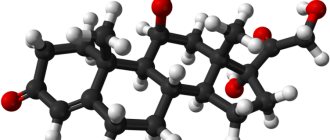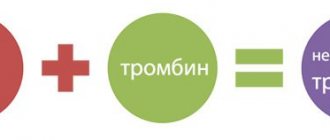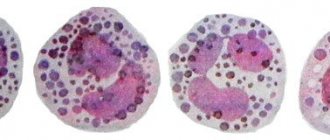How is luteinizing hormone produced?
The LH hormone (what it is in women and what it is responsible for cannot be understood without basic knowledge of how it is produced) is a kind of “regulator” of the growing up of a young girl. It is the level of its content in the blood of a female person that determines the onset of menstrual cycles during adolescence, stimulating the active development of the main genital organs - the uterus and ovaries.
LH hormone. What is it like in women? It is produced in the pituitary gland and is responsible for a number of important functions in the body.
Responsible for the direct production of luteinizing hormone in a woman’s body is the pituitary gland, located at the base of the human brain. In adulthood, the hormone ensures the regularity and appropriate duration of menstrual cycles.
Hormone functions
Functions of luteinizing hormone:
- ensures ovulation (release of a mature egg);
- stimulates the development of the corpus luteum (temporary endocrine gland);
- a normal ratio of LH and FSH is necessary for the stability of the menstrual cycle;
- affects the production of estrogen;
- activates the secretion of progesterone (the main hormone of pregnancy);
- during conception, it helps to secure the fertilized cell in the uterus.
In men, luteinizing hormone influences testosterone synthesis and spermatogenesis.
What is LH responsible for in the female body?
Based on the above-mentioned “area of responsibility” of LH, we can already conclude that it is highly important to maintain its normal level in women of all ages.
In addition to the formation of cycles, luteinizing hormone in the female body is responsible for:
- stable ovulation in the middle of each menstrual cycle;
- growth and maintenance of normal functional abilities of the ovaries and uterus;
- formation of an adult female silhouette in a young girl;
- stimulation of proper development and eggs capable of fertilization;
- appropriate production of progesterone, an equally important hormone for the female body, especially during the period of planning or immediate pregnancy;
- significant assistance to the pelvic organs in the formation of the corpus luteum in the required phase of the cycle.
Considering the above functions of the hormone in question, the conclusion about its importance for the female body and the corresponding need to control LH not only in adolescence for timely diagnosis of health problems, but also in the childbearing period, as well as at the onset of menopause, becomes clear.
Main reasons for shortage
LH can have different levels throughout the cycle. When taking tests, the doctor pays special attention to this. But why is it even necessary to take tests and look at the concentration of this hormone? The fact is that with its shortage, problems with a woman’s health and other troubles appear, which we will talk about later.
When does LH deficiency occur?
- With an increased level of prolactin - hyperprolactinemia - a reverse LH content is observed (the norm in women on the 2nd day of the cycle, as well as the subsequent days of the menstrual and follicular phases, can significantly exceed the patient’s hormone levels. But in the first days of the cycle, namely in the menstrual phase, the analysis do not prescribe, as the results may be unreliable).
- If a representative of the fair sex has luteal phase deficiency, then this behavior of the luteinizing hormone is observed.
- For obesity.
- With such a bad habit as smoking.
- If the woman’s medical history includes surgical interventions.
- In frequent stressful situations.
- Also, low levels of LH in the blood are observed in some rare diseases.
The role of LH in menopause
During menopause, the LH hormone, like other components of a woman’s hormonal background, undergoes significant changes, which means its level is highly dependent on the age and condition of the human body.
Due to aging, the concentration of luteinizing hormone increases significantly, thereby suppressing the production of other hormones, in particular estradiol. It is the “off-scale” LH level in older women that indicates the onset of menopause, also known as menopause.
A significant increase in the level of the hormone in question is due to the inability of the aging body to use it for its intended purpose, as a result of which LH accumulates, manifested in an increase in hormonal concentration in vital systems, revealed by a special blood test.
Effects of LH
Normal LH in women:
• Stimulates the growth and maturation of the follicle in the ovary;
• Promotes the emergence and development of the corpus luteum;
• Thus, LH in women regulates the formation and entry into the blood of estrogens and progesterone.
LH hormone in men stimulates the work of Leydig cells, which are located in the testicles. These cells are responsible for the formation of testosterone, the most important hormone for the normal development of the male body and sexual function.
Due to the pulsed release of FSH and LH into the blood by pituitary cells, the hormone can fluctuate at different times of the day and at different hours, while remaining within normal limits in healthy people.
Indications for the study
Medical specialists recommend monitoring luteinizing hormone by taking appropriate tests at least once every six months. However, there are emergency cases that require immediate research as soon as possible.
Such situations traditionally include:
- irregular menstrual cycles or their complete absence for several months;
- suspicions on the part of doctors for a number of medical indications for infertility of various types, premature menopause or amenorrhea;
- frequently recurring cases of miscarriage due to miscarriages at various stages;
- premature or, conversely, delayed maturation of the female reproductive system, diagnosed by qualified specialists based on a number of relevant indicators;
- frequent bleeding of unknown origin, including uterine (usually indicate the presence of malignant or benign tumors);
- the need to track ovulation for conception or check the female body for the presence of anovulatory cycles, prescribed when a married couple is planning a pregnancy;
- a significant decrease in sexual desire for a sexual partner;
- examination of a woman before undergoing artificial insemination (in vitro fertilization, also known as IVF);
- monitoring the dynamics of changes after various types of hormonal therapy;
- Excessive hair growth on a girl’s body, concentrated mostly in the face area.
Preparatory procedures before taking hormonal tests
The LH hormone (what it is in women and what it is responsible for in the body, you also need to know in order to properly prepare for the immediate test for the content of the hormone in question in the blood) is determined by taking tests. To get an accurate result, it is advisable to follow the basic recommendations of qualified specialists.
They are as follows:
- A visit to the laboratory to conduct the appropriate research must be scheduled for no later than the 9th day from the beginning of the menstrual cycle. If it was not possible to determine a favorable period at the beginning, the analysis should be postponed to the day before menstruation itself (if any), to the 20th or 21st day of the menstrual cycle.
- In advance of donating blood for hormonal testing, you must stop drinking alcohol, tobacco and taking antibacterial medications.
- 1-2 weeks before the expected day of visiting the laboratory, it is advisable to adjust your lifestyle and diet. The ideal option would be to minimize fried, spicy, salty foods with lots of spices.
- A few days before taking blood for analysis, it is important for a woman to relieve emotional and physical stress in any way that is comfortable for her. This point should not be underestimated, since psychological overload or physical exhaustion of the body can affect the result of the study on the concentration of luteinizing hormone.
- The day before taking the test in the laboratory, you should also refrain from sexual intercourse, which provokes hormonal surges in the female body.
- Like any other hormonal analysis, it is important to collect material for research on LH concentration on an empty stomach and preferably even without first drinking liquid.
What does an incorrect ratio mean?
To establish the ratio of follitropin and LH, luteotropin indicators are divided by FSH. The results obtained should fall within the range between 1 and 2.5. An increased coefficient always indicates the presence of pathological processes in the reproductive system.
Common causes of imbalance:
- The onset of early menopause.
- Benign tumors.
- Lack of follicles in the ovaries.
- Androgen resistance syndrome.
- Cysts on the ovaries.
It is important to understand that test results are greatly influenced by the patient’s mood, taking any medications, physical stress, etc. Therefore, you need to approach the preparation for testing responsibly.
Low values usually indicate the absence of ovulatory processes. If an increased coefficient is observed after the onset of menopause, then this is the norm.
How to get tested
The LH hormone (what is it in women and how can its level in the blood of the female half of humanity be controlled) is determined based on test results.
Detailed description of the analysis procedure:
- After making sure that a woman planning to take a blood test to determine the level of luteinizing hormone in her body is in normal health, having first measured her blood pressure, the medical laboratory worker will ask her to take the most relaxed position (sitting or lying down).
- A special tourniquet is attached above the elbow, clamping the blood flow through the veins in the arm.
- To collect a sufficient amount of biological material and clearly identify the vein from which blood is planned to be drawn, the patient will be asked to flex and straighten his hand into a fist for some time.
- After carefully placing the needle in the venous system, the required amount of blood will be drawn by a medical professional, which will then be sent directly to the laboratory.
- Upon completion of the procedure, the woman is traditionally sealed at the location of the needle removed from the vein and is advised to wait 3–5 minutes. hold your arm in a bent position at the elbow.
- The final step is usually to re-measure blood pressure to ensure that the patient is feeling normal after taking some blood and is able to continue moving independently outside the medical facility.
Why do you need to take this test?
If the results of the analysis differ from those indicators that are defined as the LH norm in women, then this may indicate many pathologies in the body. These may be diseases such as infertility, menopause, Turner syndrome and some others. In order to accurately determine the diagnosis, it is necessary, having fulfilled all the preparation requirements, to take an LH test. The norm for women on the 3rd day of the cycle will not differ significantly until the 14th day, so there is no point in taking it for several days for the accuracy of the results, with the exception of an irregular cycle.
Table of indicators of LH norms at different periods of the cycle
Based on the well-known fact about the influence of luteinizing hormone of the pituitary gland on the functioning of the reproductive organs of the female body, its variations depending on the specific period of the menstrual cycle are logical.
| Phase of the menstrual cycle | Normal levels of luteinizing hormone during this period |
| First phase (or follicular) | 1.45 – 10 mU/ml |
| Ovulatory phase (around the middle of the cycle) | 6.15 – 16.8 honey/ml |
| Second phase (or luteal) | 1.07 – 9.1 honey/ml |
| Menopause period | 12 – 54 mU/ml |
As can be seen from the table above, normally, LH levels at the beginning and end of the cycle should be the same, and during the ovulatory phase there should be a surge of luteinizing hormone, without which the maturation of the follicle, the formation of the corpus luteum and the production of progesterone in the proper amount are impossible.
It is important to understand that the norm indicators described above are generally accepted and standard.
In real life, each woman’s body is individual and, due to its specific characteristics, these numbers may vary.
That is why it is important to know your own physiology, including hereditary characteristics and regular consultations with the same qualified specialist who prescribes appropriate procedures to determine the level of LH concentration in the blood of the woman being examined.
When is a luteotropin blood test prescribed?
Studies are prescribed strictly according to the doctor’s indications, taking into account the existing medical history. Unauthorized diagnosis can lead to erroneous interpretation of the results, so most often a blood test for LH is prescribed for the following situations and diseases:
- Irregular menstrual cycle.
- Delay of menstruation.
- Lack of ovulation.
- Having a diagnosis of endometriosis.
- Infertility.
- Inability to bear a fetus.
- Uterine bleeding of unknown origin.
- Anomalies of sexual development.
- Polycystic ovary syndrome.
- Corpus luteum cyst.
- Follicular cyst.
- Pituitary adenoma.
- Ovarian wasting syndrome.
- Monitoring hormonal treatment.
The gynecologist has the right to prescribe tests in other cases if there is a suspicion of the hormonal nature of the pathology.
Attention! Laboratory testing of luteinizing hormone requires special preparation. Depending on the medical history, a woman should be tested on certain days of the menstrual cycle.
PH in women of different ages
Not only the phase of the menstrual cycle, but also a kind of “wear and tear” of the body due to the increasing age of a woman can have a significant impact on changes in the concentration of luteinizing hormone.
| Age of the woman being examined | LH level considered normal in this period |
| From birth to 1 year | up to 0.8 mU/ml |
| From 1 year to 4 years | 0.9 – 2.0 mU/ml |
| Adolescence (9 – 15 years) | 0.5 – 4.6 mU/ml |
| Puberty (16 – 17 years old) | 0.4 – 16 mU/ml |
| After 18 years (including childbearing age until menopause) | 2.2 – 11.2 honey/ml |
| After 50 years (or earlier if menopause occurs suddenly) | 11.3 – 53 honey/ml |
The fact of a significant difference in the concentration of luteinizing hormone in the blood of women of different age groups is due to the aging of the ovaries and the partial loss of their ability to stimulate regular ovulation in each menstrual cycle.
Use of luteinizing hormone as a medicine
Artificial luteinizing hormone has found its use as a medicine. For example, luteinizing hormone in combination with follicular hormone is part of pergonal and some other urinary gonadotropins (highly purified gonadotropins usually contain small doses of LH). There is also recombinant lutropin-alpha, which is used in the treatment of infertility (most often it is used in IVF to stimulate ovarian growth). Human chorionic gonadotropin, which binds to the same receptors as luteinizing hormone, can be used as an anti-fertility drug instead of LH.
Causes of low LH levels
Considering the high degree of importance of LH for the female body at any age, it is necessary to clearly understand the consequences of the deviations expressed in the reduced content of the hormone in question in the blood.
The main ones include:
- presence of excessive excess weight, obesity;
- insufficiency of the second phase of the menstrual cycle;
- prolonged smoking or drinking alcohol;
- taking medications that are difficult for the body and require restoration of defenses;
- recent surgical interventions;
- prolonged absence of menstruation in women at an age when menstruation should be regular;
- multifollicular ovaries or their advanced form - polycystic disease;
- frequent stress in the daily life of the subject;
- delayed physical or mental development as a result of genetic diseases;
- significant deviations in the normal functioning of the pituitary gland and hypothalamus, responsible for the production of luteinizing hormone;
- excessive production of prolactin, suppressing the increase in LH levels;
- pregnancy period;
- irregular menstrual cycle in women of childbearing age.
What is “ICA LH factor”?
The abbreviation “ICA LH factor” can often be seen on the packaging of ovulation tests.
In medical terms, this is a highly sensitive immunochromatographic test that detects the content of the hormone lutein in the urine. ICA LH factor is presented in the form of special test strips that are treated with chemical reagents. They are designed to test urine, the stream of which should hit the strip.
The result is recorded within a minute after urination. If the LH surge does not occur, then the second stripe will either be absent or have weak and pale outlines. In the preovulatory period, the second line is usually bright in color. This is the operating principle of the “ICA LH factor”.
In conclusion, it must be said that the levels of the lutein hormone depend on many factors:
- age;
- phase of the menstrual cycle;
- stress;
- diet;
- physical exercise;
- endocrine diseases;
- smoking;
- pregnancy;
- laboratory reference values;
- FSH numbers.
The result cannot be interpreted in isolation from the above nuances. The highest hormone values are recorded before follicle rupture, which is the physiological norm. There is an average norm, but it is most reasonable to compare the obtained figures with anamnesis and other factors.
Elevated LH levels
Deviations in the concentration of luteinizing hormone are not always reflected in a decrease in its level. An equally significant reason for consultation with a medical specialist is a significant increase in its content in the blood of the woman being examined, provoked by a number of reasons.
The most common of them traditionally include:
- exhaustion of the nervous system due to frequent stress and constant psychological tension in a woman’s everyday life;
- general weakness or wear and tear of the body due to excessive physical exertion (usually due to visiting the gym and training there according to an incorrectly designed training program);
- frequent use of a certain number of medications that provoke hormonal imbalance;
- deviations from the normal functioning of the pituitary gland and hypothalamus, most often observed after the woman being examined has suffered injuries, bruises, or surgical interventions;
- dysfunction of the gonads, requiring additional examination to determine the causes of dysfunction of this kind;
- pathological changes in the functioning of the kidneys and adrenal glands;
- diagnosing premature dysfunction of the reproductive organs in the female body;
- a sharp significant decrease in the body weight of the woman being examined, both as a result of the disease and the usual diet for weight loss;
- the initial stage of the development of endometriosis, which can not only provoke hormonal imbalance, but also cause significant damage to women’s health in general;
- neoplasms of various types in one of the lobes of the pituitary gland, most often the anterior one.
What does it mean if luteinizing hormone is elevated in women?
Normal levels of the hormone vary among women. This determines that the value of the reference values is presented as an interval, and not as exact values. The main reason for the increase in LH in women in the follicular phase is close ovulation. As a rule, ovulation occurs within the next 24 hours, and LH concentrations return to normal values within two days.
If the LH content deviates by less than 5 to 10 units, then there is nothing to worry about. The patient is re-measured the hormone after a few days. It is important to eliminate physical and emotional stress during this period.
A consistently high concentration of LH in the blood indicates:
- disruption of the hormone secretory function of the anterior pituitary gland, when it begins to uncontrollably secrete the hormone in excess quantities;
- primary dysfunction of the reproductive glands;
- polycystic ovary syndrome (Stein-Leventhal syndrome), in which large-scale disruptions occur in the functioning of the endocrine system. Changes in functional activity are observed in the work of the ovaries, adrenal cortex, pituitary gland and hypothalamus. The disease is manifested by oligomenorrhea, infertility, hirsutism, masculinization, obesity, alopecia, severe acne, depressive disorders, etc.;
- malignant lesion of the pituitary gland;
- premature onset of puberty in a girl. The average age of first menarche is 11–13 years. Precocious puberty syndrome is diagnosed if menstruation and the formation of secondary sexual characteristics in a girl began at age 8. It should be borne in mind that in the last 30 years among the female population there has been a tendency towards an earlier puberty. What makes it necessary to revise modern standards;
- congenital genetic disorders affecting the number of chromosomes. For example, with Shereshevsky-Turner syndrome, a girl has only one of two XX chromosomes. In most cases, patients are infertile;
- endometriosis;
- renal failure, etc.
Among the non-pathological aspects, the influence of drugs should be highlighted. For example, clomiphene®, naloxone®, bombesin®, pyronol®, mestranol® and drugs based on female sex hormones significantly distort the reliability of laboratory tests.
Adjusting LH levels
The LH hormone (what it is in women needs to be found out for the prevention of various pathologies) has a certain level, which is important to correctly adjust if a deviation from generally accepted norms in medicine is detected.
Depending on the circumstances, an increase or decrease in luteinizing hormone is carried out through surgery or taking special hormonal medications prescribed by a qualified doctor: a gynecologist, endocrinologist, therapist or reproductive specialist.
If it is necessary to provoke conception after a period of hormone therapy, women being examined are traditionally prescribed combined oral contraceptives, which allow the reproductive system to rest, taking care of the production of the appropriate amount of hormones.
Falling into a “shock” state after abruptly stopping COCs, in most cases the ovaries restore their functions, and normalization of the LH level in the blood occurs automatically.
It is important to understand in this case the need to construct a regimen for taking hormonal drugs exclusively at an appointment with a specialist who knows the characteristics of the body of the woman being examined, and not by making an independent decision.
Otherwise, you may not only fail to normalize the level of luteinizing hormone, but also provoke disturbances in the production of a number of other hormones, for example, prolactin.
In the absence of positive dynamics after taking oral contraceptives by qualified specialists, in most cases, in the absence of contraindications due to the patient’s health, it is proposed to resort to surgical intervention, which is a kind of artificial stimulation of ovulation.
One of the most common operations of this kind is laparoscopy. This type of medical manipulation involves cutting the outer layer of the ovaries in order to facilitate the further release of an egg ready for fertilization.
After restoring the normal functioning of the reproductive organs, in accordance with the constitution of the body and the physiological characteristics of the body, the concentration of luteinizing hormone should be restored.
In some cases, in particular with the timely diagnosis of tumors or other dysfunctions of the kidneys and adrenal glands, to correct LH levels, medical specialists prescribe complex treatment, including not only surgery, but also subsequent hormonal therapy with serious drugs.
In the vast majority of cases, hormonal treatment to restore the proper level of LH is carried out using medications containing progesterone, estrogen, androgen, as well as luteinizing hormone itself (Pergonal, Luteotropin, and so on).
In the absence of serious indications for drug treatment or surgery, it is advisable for a woman to try to adjust the LH concentration using traditional methods.
These include daily oral use:
- natural apple juice;
- pomegranate juice;
- freshly squeezed citrus juice;
- linseed oil;
- herbal infusions, including mint, linden, hops or cones;
- berry liqueurs from raspberries, strawberries, wild strawberries and so on.
Based on the above facts, which prove the high degree of importance of monitoring the LH hormone in women, as well as explaining what it is and how deviations from generally accepted norms can be diagnosed, we can conclude that it is necessary to regularly donate blood for hormonal testing in order to avoid the development of serious diseases.
Article design: Oleg Lozinsky
Luteal phase deficiency
If ovarian function is disrupted, luteal phase deficiency (LPF) may occur. The main feature of this disease is dysfunction of the corpus luteum, which occurs due to a lack of progesterone in the body. With NLF, the uterus does not have time to prepare for pregnancy. This leads to the death of the fertilized egg, which means infertility.
You can learn about luteal phase deficiency by analyzing the basal temperature chart. To confirm NDF, you may need to have a blood test. You also need to remember that if the luteal phase is insufficient, the time interval between ovulation and the beginning of a new menstruation decreases. In other words, if less than 10 days pass between ovulation and new menstruation, you need to consult a doctor. Treatment for this disorder involves taking medications that reduce the amount of prolactin and androgens.











